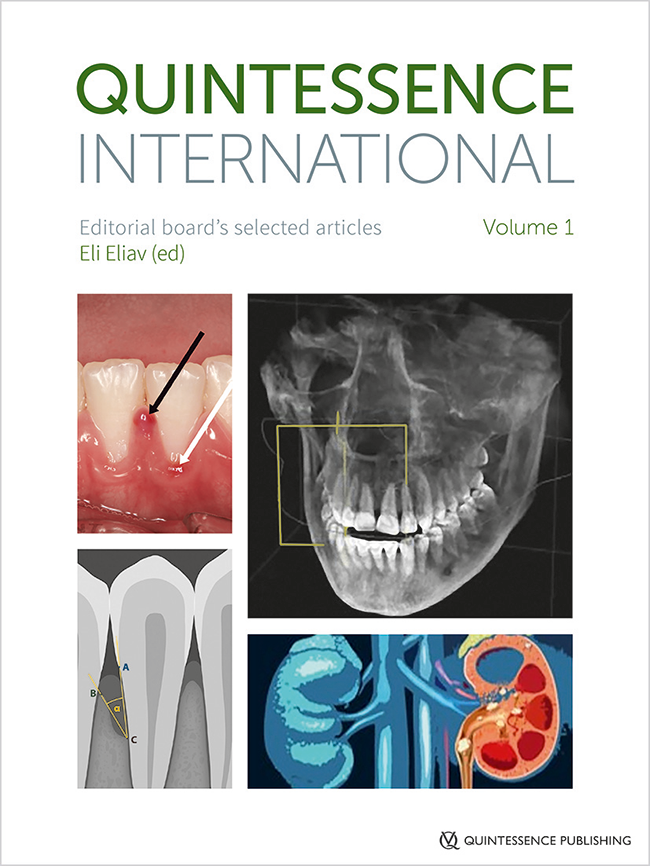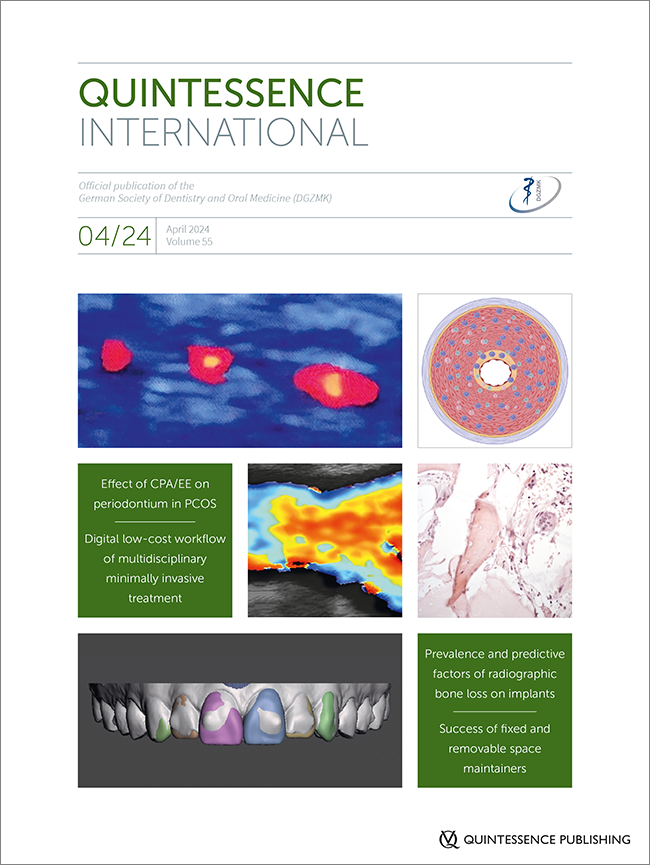Quintessence International, 3/2024
DOI: 10.3290/j.qi.b5143075, PubMed-ID: 38534033Seiten: 176-177, Sprache: EnglischNahlieli, Oded / Eliav, Eli
EditorialQuintessence International, 3/2024
DOI: 10.3290/j.qi.b5143737, PubMed-ID: 38536123Seiten: 177-178, Sprache: EnglischUlrich, Ina B. / Eliav, Eli
EditorialQuintessence International, 2/2024
DOI: 10.3290/j.qi.b5031229, PubMed-ID: 38414367Seiten: 88-89, Sprache: EnglischArany, Szilvia / Caprio, Thomas V. / Medina-Walpole, Annette / Eliav, Eli
Quintessence International, 1/2024
DOI: 10.3290/j.qi.b4893093, PubMed-ID: 38259031Seiten: 2-3, Sprache: EnglischBiron, Adi / Eliav, Eli / McNeil, Rotem
EditorialQuintessence International, 5/2023
DOI: 10.3290/j.qi.b4105017, PubMed-ID: 37204104Seiten: 356-357, Sprache: EnglischEliav, Eli / Levin, Liran
EditorialQuintessence International, 2/2023
DOI: 10.3290/j.qi.b3879801, PubMed-ID: 36762850Seiten: 90-91, Sprache: EnglischTeich, Sorin / Eliav, Eli
EditorialJournal of Oral & Facial Pain and Headache, 2/2023
DOI: 10.11607/ofph.2023.2.eSeiten: 77-78, Sprache: EnglischEliav, Eli / Arany, Szilvia
EditorialQuintessence International, 1/2023
DOI: 10.3290/j.qi.b3803631, PubMed-ID: 36637261Seiten: 4, Sprache: EnglischEliav, Eli
EditorialJournal of Oral & Facial Pain and Headache, 1/2022
DOI: 10.11607/ofph.3050Seiten: 67-77, Sprache: EnglischOzasa, Kana / Noma, Noboru / Kobayashi, Momoyo / Takizawa, Keita / Young, Andrew / Eliav, Eli / Imamura, Yoshiki
Aims: To investigate the predictive power of depression and anxiety for conditioned pain modulation (CPM) and to examine the relationships of CPM at 40°C and CPM at 47°C with age, disease-related pain, pain duration, and psychosocial factors in burning mouth syndrome (BMS).
Methods: A total of 22 patients with BMS and 22 healthy female controls participated in this study. Temporal summation was used as the test stimulus for CPM, and subsequent exposure either to a nonpainful (40°C) or a painful (47°C) Peltier thermode was used as the conditioning stimulus. CPM was calculated as the difference in pain perception following the conditioning stimulus. Psychosocial factors were examined using the Profile of Mood States (POMS) and the State-Trait Anxiety Inventory (STAI).
Results: State anxiety and tension-anxiety scores were significantly higher for patients with BMS than for control participants. Multiple regression analyses showed that CPM47°C was affected by vigor, fatigue, confusion, and trait anxiety (adjusted R2 = 0.685, F = 5.147, P = .098). The corresponding analysis for CPM40°C showed that the model was not predictive for the following variables: disease-related pain, pain duration, or components of the POMS or STAI. A significant positive correlation was found between CPM47°C and trait anxiety, suggesting that trait anxiety negatively affected the endogenous pain modulation system.
Conclusion: Increases in trait anxiety reduced the CPM effect. These findings suggest that CPM impairments and increases in trait anxiety are involved in the development of BMS.
Schlagwörter: anxiety, burning mouth syndrome, conditioned pain modulation, depression, state-trait anxiety inventory
Journal of Oral & Facial Pain and Headache, 3/2021
DOI: 10.11607/ofph.3003Seiten: 230-240, Sprache: EnglischKhan, Junad / Wang, Qian / Korczeniewska, Olga A. / Eliav, Rotem / Ren, Yanfang / Eliav, Eli
Aims: To investigate the role of exercise-induced hypoalgesia (EIH) in the development of neuropathic pain (NP) following infraorbital nerve (ION) injury and to explore possible underlying mechanisms defining the differences between rats with high and low EIH.
Methods: EIH was evaluated by measuring the percentage of withdrawal responses to a series of 30 mechanical stimuli applied to the hind paw before and after 180 seconds of exercise on a rotating rod. The rats were assigned to low- and high-EIH groups based on reduction in the percent of withdrawal responses following exercise. NP was induced in high- and low-EIH rats via ION constriction injury. Rats were tested with graded nylon monofilaments to establish the withdrawal threshold. Increasingly stiff monofilaments were applied to the ION territory until there was a clear withdrawal by the rat. This was repeated a total of three times. A decreased withdrawal threshold indicates allodynia. Testing was performed at baseline and at 3, 10, and 17 days following the injury. On day 17 postinjury, IONs were harvested for the assessment of interleukin (IL)-6, IL-1β, and IL-10 levels. Samples from high-EIH and low-EIH surgically naïve rats served as control for the cytokines study. In this second part of the study, the effects of cannabinoid 1 (CB1) and cannabinoid 2 (CB2) antagonists and naltrexone on EIH profiles and on the withdrawal thresholds to mechanical stimulation were measured. EIH and withdrawal thresholds in high- and low-EIH rats were measured before and after administration of antagonists.
Results: Low-EIH rats developed significantly more pronounced allodynia in the ION territory following injury compared to high-EIH rats. At 17 days postinjury, ION IL-1β levels were higher in low-EIH rats, and IL-10 levels were higher in high-EIH rats. CB1 antagonist blocked the analgesic effect induced by exercise in high- but not in low-EIH rats. The CB2 antagonist had no significant effect on high- or low- EIH rats. Naltrexone blocked the effects of EIH in both high- and low-EIH rats. Exercise induced a significant analgesic effect in high-EIH but not in low-EIH rats. CB1 or CB2 antagonist administration had no effect on pre-exercise responses to mechanical stimulation, while naltrexone administration resulted in significant allodynia in both low- and high-EIH rats.
Conclusion: This study demonstrated substantial differences between rats with high and low EIH. The results suggest that following ION injury, high-EIH rats may have a more prominent or activated endocannabinoids system and that their inflammatory response is moderated, with higher levels of IL-10 and lower levels of IL-1β.
Schlagwörter: exercise-induced hypoalgesia, nerve injury, orofacial neuropathic pain, pain modulation, trigeminal





